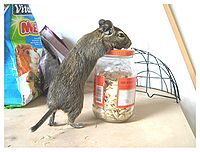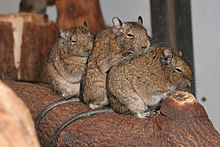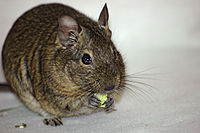- Degu
-
Degu 
Conservation status Scientific classification Kingdom: Animalia Phylum: Chordata Class: Mammalia Order: Rodentia Suborder: Hystricognathi Family: Octodontidae Genus: Octodon Species: O. degus Binomial name Octodon degus
(Molina, 1782)Synonyms Sciurus degus Molina, 1782
Octodon degus: Waterhouse, 1848The degu (Octodon degus,
 /ˈdeɪɡuː/) is a small caviomorph rodent that is endemic to central Chile.
/ˈdeɪɡuː/) is a small caviomorph rodent that is endemic to central Chile.It is sometimes referred to as the brush-tailed rat, and is also called the common degu, to distinguish it from the other members of the genus Octodon. Other members are also called degus, but they are distinguished by additional names. The name "degu" on its own, however, indicates either the genus Octodon or, more usually, O. degus. Degus are in the parvorder Caviomorpha of the infraorder Hystricognathi, along with the chinchilla and guinea pig. The word degu comes from the Mapudungun dewü (mouse, rat).[2]
Contents
Description
The degu is a small rodent with a body length of 25.0 to 31.0 centimetres (9.8–12.2 in) and a weight of 170 to 300 grams (6.0 to 11 oz). It has yellow-brown fur above and creamy-yellow below, with yellow around the eyes and a paler band around the neck. It has a long, thin tail with a tufted black tip, dark sparsely-furred ears, and pale grey toes. Its fifth toe is small with a nail, rather than a claw, on the forefeet. Its hindfeet are bristled. Its cheek teeth are shaped like figures-of-eight, hence the degu's genus name "Octodon".[3]
Social behavior
Degus are highly social. They live in burrows, and, by digging communally, they are able to construct larger and more elaborate burrows than they could on their own.[4] Degus digging together coordinate their activities, forming digging chains.[5] Females living in the same group have been shown to spontaneously nest communally;[6][7] they nurse one another's young. They spend a large amount of time on the surface, where they forage for food.[5] When foraging, their ability to detect predators is increased in larger groups,[8] and each animal needs to spend less time in vigilance. Degus exhibit a wide array of communication techniques. They have an elaborate vocal repertoire comprising up to 15 unique sounds,[9] and the young need to be able to hear their mother's calls if the emotional systems in their brains are to develop properly.[10] They use their urine to scent mark,[11] and experiments have shown that they react to one another's marks,[12] although in males the hormone testosterone may suppress their sense of smell somewhat.[13]
Degus are seasonal breeders; the breeding season for wild degus begins in the Chilean autumn when there is roughly 12 hours light:12 hours darkness,[14] with pups born in early to mid spring.[15] Female degus are pregnant for approximately ninety days,[3][16] having a comparatively long gestation period compared to other non-caviomorph rodents. Female pregnant weight varies over the course of gestation and according to litter size;[17] litters contain an average of six pups,[6] but size can range from one or two up to twelve young.[17] Degu pups are born relatively precocial, fully furred and with eyes open, and their auditory and visual systems are functional at birth.[18] Unlike most other rodents, male degus also take part in protecting and raising their pups until they are old enough to leave the family.[19]
Unlike some other octodontids, degus are diurnal[20] (active during the day), and they have good vision. Their retinas include rod cells and two types of cone cells, corresponding to peak sensitivity in the green and ultraviolet regions of the spectrum.[21] Behavioral experiments have shown that degus are able to discriminate ultraviolet light from the wavelengths visible to humans; it is likely that this ultraviolet sensitivity has a social function, since both their ventral (stomach) fur and their urine are highly UV reflective.[22]
Diet
Degus are strictly herbivorous, in the wild feeding on grasses and browsing the leaves of shrubs, though they will also take seeds.[23] Throughout much of the year forage is dried[20] and so degus are specially adapted to a very high fibre intake,[24] and this varies between food types and environmental conditions.[25] Like some other herbivores such as rabbits, they perform coprophagy (faecal reingestion) so as to extract more nutrition from their diet.[26] This also serves to maintain healthy gut function during times when food is scarce.[26] Although they are active by day, in high summer they do not leave their burrows in the middle of the day[20] and instead emerge to forage in the mornings and evenings.
Perhaps the most remarkable feature of degu physiology is their intolerance of dietary sugar. Degus have been found to have a divergent insulin structure (one of the hormones that regulates blood glucose level) and so are highly susceptible to developing diabetes mellitus when fed regularly on a diet containing free sugars.[27] This is thought to be due to evolutionary pressure arising from the lack of availability of free sugars in the degu's natural environment.[28] Because of this, the ingredients of non-degu specific hard feed formulations given to captive degus should be checked for free-sugar substances, such as molasses, honey and glucose syrup.[citation needed]
Research subjects
 Degus are extremely intelligent and have a good ability to solve problems[29]
Degus are extremely intelligent and have a good ability to solve problems[29]
Degus entered the research spotlight due to their unique relationship with sugar and diabetes, but are also studied for a wide variety of other reasons. Neuroscientists at the Riken Institute in Tokyo, Japan, used degus for research into tool use in animals with good eye-and-paw coordination, in which they spontaneously learned to use a tiny rake to retrieve out-of-reach seeds.[29] Degus have also been found to spontaneously stack objects in order of decreasing size.[30] In both cases it is the first time these behaviours have been recorded in animals other than apes and birds.
Another interesting area of degu research is circadian rhythm function, i.e. the ability of the brain to tell what time of day it is. Degus have the ability to show both diurnal and nocturnal rhythms if the environment permits,[31] allowing a unique opportunity for study. Degus can take cues that do not relate to day length, such as temperature,[32] melatonin levels[33] and even scents from other degus[34] to adjust their rhythms.
Degus are also invaluable in development and aging studies. Research has shown that separation anxiety caused by separating pups from their mother from an early age for periods of half an hour or more can cause developmental and behavioural changes in later life, similar to ADHD in humans.[35] In elderly degus, neural markers have been discovered which are remarkably similar to those in humans with Alzheimer's disease,[36] which is the first time this has been seen in a non-human mammal.[citation needed]
Pets
After initial interest into degus as research subjects, degus have become popular as pets, though until very recently they were seldom found in pet shops. Their advantages over traditional small pets are their diurnal habits, bubbly personalities, the haired tail (as compared to rats and mice) and their lifespan: they are reported to live up to 13 years under ideal circumstances (though a poor gene pool/genetic background often reduces a pet degu's lifespan significantly).[citation needed] The average lifespan of a degu in captivity is typically around 6–8 years of age. One disadvantage of the degu as a pet is their predisposition to chewing, due to their continually growing incisor and molar teeth.[3] For this reason degus cannot be housed in plastic-bottomed cages typically found in pet stores. A metal cage with multiple levels made for rats and secured double latches works best. It is important to line the levels with grass mats or a soft fabric so that the degus do not get bumble feet.[citation needed] Untamed degus, as with most small animals, can be prone to biting, but their intelligence makes them easy to tame. Regular non-predatory handling and food offerings help with this transition. It is important never to try to catch a degu by the tail because it will fall off easily and is painful to the creature. If this occurs it will not grow back. Degus often 'groom' their human owners, by a gentle nibbling action, and readily bond with any person spending time with them. Degus will bathe themselves if given a bowl of chinchilla dust weekly.[citation needed]
Gallery
References
- ^ Lessa, E.; Ojeda, R.; Bidau, C. (2008). "Octodon degus". IUCN Red List of Threatened Species. Version 2008. International Union for Conservation of Nature. http://www.iucnredlist.org/apps/redlist/details/15088. Retrieved 5 January 2009.
- ^ Muñoz Urrutia, Rafael, ed. (2006) (in Spanish), Diccionario Mapuche: Mapudungun/Español, Español/Mapudungun (2nd ed.), Santiago, Chile: Editorial Centro Gráfico, pp. 104, 105, 141, ISBN 956-8287-99-X
- ^ a b c Woods, C.; Boraker, D. (21 November 1975), "Octodon degus", Mammalian Species 67: 1–5, http://www.science.smith.edu/departments/Biology/VHAYSSEN/msi/pdf/i0076-3519-067-01-0001.pdf
- ^ Ebensperger, L. A.; Bozinovic, F. (2000), "Communal burrowing in the hystricognath rodent, Octodon degus: A benefit of sociality?", Behavioural and Ecological Sociobiology 47 (5): 365–369, doi:10.1007/s002650050678, ISSN (Print) 1432-0762 (Online) 0340-5443 (Print) 1432-0762 (Online)
- ^ a b Ebensperger, L. A.; Bozinovic, F. (2000b), "Energetics and burrowing behaviour in the semifossorial degu Octodon degus (Rodentia: Octodontidae)", Journal of Zoology 252 (2): 179–186, doi:10.1111/j.1469-7998.2000.tb00613.x
- ^ a b Ebensperger, L.A.; Veloso, C.; Wallem, P. (2002), "Do female degus communally nest and nurse their pups?", Journal of Ethology 20 (2): 143–146, doi:10.1007/s10164-002-0063-x, ISSN (Print) 1439-5444 (Online) 0289-0771 (Print) 1439-5444 (Online)
- ^ Ebensperger, L.A.; Hurtado, M.; Lacey, E.; Chang, A.; Chang, AT (2004), "Communal nesting and kinship in degus (Octodon degus)", Naturwissenschaften 91 (8): 391–395, doi:10.1007/s00114-004-0545-5, ISSN (Print) 1432-1904 (Online) 0028-1042 (Print) 1432-1904 (Online), PMID 15309311
- ^ Quirici, V.; Castro, R.A.; Oyarzun, J.; Ebensperger, L.A. (2008), "Female degus (Octodon degus) monitor their environment while foraging socially", Anim Cogn. 11 (3): 441–448, doi:10.1007/s10071-007-0134-z, ISSN (Print) 1435-9456 (Online) 1435-9448 (Print) 1435-9456 (Online), PMID 18214556
- ^ Long, C.V. (2007), "Vocalisations of the degu (Octodon degus), a social caviomorph rodent", Bioacoustics 16: 223–244, ISSN 0952-4622
- ^ Ziabreva, I.; Schnabel, R.; Poeggel, G.; Braun, K. (2003), "Mother's voice "buffers" separation-induced receptor changes in the prefrontal cortex of Octodon degus", Neuroscience 119 (2): 433–441, doi:10.1016/S0306-4522(03)00123-4, PMID 12770557
- ^ Kleiman, D.G. (1974), Rowlands, I. W.; and Weir, B. J., ed., Patterns of behaviour in hystricomorph rodents. Symp Zool Soc Lond., 34: 171-209. In: The Biology of Hystricomorph Rodents, London: Academic Press
- ^ Fischer, R.; Meunier, G. (1985), "Responses to conspecifics' urine by the degu Octodon degus", Physiological Behaviour 34 (6): 999–1001, doi:10.1016/0031-9384(85)90027-7
- ^ Jechura, T.; Walsh, J.; Lee, T. (2003), "Testosterone suppresses circadian responsiveness to social cues in the diurnal rodent Octodon degus", Journal of Biological Rhythms 18 (1): 43–50, doi:10.1177/0748730402239675, PMID 12568243
- ^ Ebensperger, L.A.; Caiozzi, A. (2002), "Male degus, Octodon degus, modify their dustbathing behviour in response to social familiarity of previous dustbathing marks", Revista Chilena de Historia Natural 75: 157–163, doi:10.4067/S0716-078X2002000100015, ISSN 0716-078X
- ^ Bozinovic, F.; Bacigalupe, L.; Vasquez, R.; Visser, H.; Veloso, C.; Kenagy, G. (2004), "Cost of living in free-ranging degus (Octodon degus): Seasonal dynamics of energy expenditure", Comparative Biochemistry and Physiology A 137 (3): 597–604, doi:10.1016/j.cbpb.2003.11.014, PMID 15123196
- ^ Brown, C.; Donnelly, T. (2001), "Cataracts and reduced fertility in degus (Octodon degus): Contracts secondary to diabetes mellitus", Lab Animal (NY) 30: 25–26, ISSN 0093-7355
- ^ a b Long, C.V.; Ebensperger, L.A. (2009), "Pup growth rates and breeding female weight changes in two populations of captive bred degus (Octodon degus), a precocial caviomorph rodent", Reprod Domest Anim. 45 (6): 975–82, doi:10.1111/j.1439-0531.2009.01470.x, ISSN 0936-6768., PMID 19497026
- ^ Reynolds, T.; Wright, J. (1979), "Early postnatal physical and behavioural development of degus (Octodon degus)", Lab Animal (NY) 13 (2): 93–9, doi:10.1258/002367779780943576
- ^ http://www.exoticnutrition.com/breedingdegus.html
- ^ a b c Kenagy, G.; Nespolo, R.; Vasquez, R.; Bozinovic, F. (2002), "Daily and seasonal limits of time and temperature to activity of degus", Revista Chilena de Historia Natural 75 (3): 567–581, doi:10.4067/S0716-078X2002000300008, ISSN 0716-078X
- ^ Cha'vez, A.; Bozinovic, F.; Peich, F.; Palacios, A. (2003), "Retinal spectral sensitivity, fur coloration and urine reflectance in the genus Octodon (Rodentia): Implications for visual ecology", IOVS 44 (5): 2290–2296, doi:10.1167/iovs.02-0670
- ^ Palacios, A.; Bozinovic, F. (2003), "An "enactive" approach to ingtegrative and comparative biology: Thoughts on the table", Biol Res. 36 (1): 101–105, doi:10.4067/S0716-97602003000100008, ISSN 0716-9760, PMID 12795209
- ^ Bozinovic, F.; Gallardo, P.A.; Visser, G.H.; Cortés, A. (2003), "Seasonal acclimatization in water flux rate, urine osmolality and kidney water channels in free-living degus: Molecular mechanisms, physiological processes and ecological implications", J Exp Biol. 206 (Pt 17): 2959–2966, doi:10.1242/jeb.00509, PMID 12878664
- ^ Langer, P. (2002), "The digestive tract and life history of small mammals", Mammal Review 32 (2): 107–131, doi:10.1046/j.1365-2907.2002.00101.x
- ^ Gutiérrez, J.; Bozinovic, F. (1998), "Diet selection in captivity by a generalist herbivorous rodent (Octodon degus) from the Chilean costal desert", Journal of Arid Environments 39 (4): 601–607, doi:10.1006/jare.1998.0412
- ^ a b Kenagy, G.; Veloso, C.; Bozinovic, F. (1999), "Daily rhythms of food intake and feces reingestion in the degu, an herbivorous Chilean rodent: Optimizing digestion through coprophagy", Physiological and Biochemical Zoology 72 (1): 78–86, doi:10.1086/316644, PMID 9882606
- ^ Opazo, J.C.; Soto-Gamboa, M.; Bozinovic, F. (2004), "Blood glucose concentration in caviomorph rodents", Comp. Biochem. Physiol. A. 137: 57=64, doi:10.1016/j.cbpb.2003.09.007
- ^ Nishi, M.; Steiner, D. (2003), "Cloning of complementary DNA's encoding islet amyloid polypeptide, insulin, and glucagon precursors from a New World rodent, the degu, Octodon degus", Molecular Endocrinology 4 (8): 1192–8, doi:10.1210/mend-4-8-1192, PMID 2293024
- ^ a b Okanoya, K.; Tokimoto, N.; Kumazawa, N.; Hihara, S.; Iriki, A.; Ferrari, Pier Francesco (2008), Ferrari, Pier Francesco, ed., "Tool-Use Training in a Species of Rodent: The Emergence of an Optimal Motor Strategy and Functional Understanding", PLoS One 3 (3): e1860, doi:10.1371/journal.pone.0001860, PMC 2268009, PMID 18365015, http://www.pubmedcentral.nih.gov/articlerender.fcgi?tool=pmcentrez&artid=2268009
- ^ Tokimoto, N.; Okanoya, K. (2004), "Spontaneous construction of "Chinese boxes" by degus (Octodon degus): A rudiment of recursive intelligence?", Japanese Psychological Research 46 (3): 255–261, doi:10.1111/j.1468-5584.2004.00257.x
- ^ Kas, M. J. H.; Edgar, D. M. (2000), "Photic phase response curve in Octodon degus: Assessment as a function of activity phase preference", American Journal of Physiology 277 (5): R1385–1389, PMID 10801311, http://ajpregu.physiology.org/cgi/content/full/278/5/R1385
- ^ Kas, M.J.; Edgar, D.M. (1998), "Crepuscular rhythms of EEG sleep-wake in a hystricomorph rodent, Octodon degus", J. Biol. Rhythms 13 (1): 9–17, doi:10.1177/074873098128999871, PMID 9486839
- ^ Morris, L.G.; Tate, B.L. (2007), "Phase response curve to melatonin in a putatively diurnal rodent, Octodon degus", Chronobiol. Int. 24 (3): 407–411, doi:10.1080/07420520701420352, PMID 17612940
- ^ Jechura, T.J.; Mahoney, M.M.; Stimpson, C.D.; Lee, T.M. (2006), "Odor-specific effects on reentrainment following phase advances in the diurnal rodent, Octodon degus", Am. J. Physiol. Regul. Integr. Comp. Physiol. 291 (6): R1808–1816, doi:10.1152/ajpregu.00005.2006, ISSN 0363-6119/06, PMID 16840658
- ^ Zehle, S.; Bock, J.; Jezierski, G.; Gruss, M.; Braun, K. (2007), "Methylphenidate treatment recovers stress-induced elevated dendritic spine densities in the rodent dorsal anterior cingulate cortex", Dev. Neurobiol. 67 (14): 1891–1900, doi:10.1002/dneu.20543, PMID 17874461
- ^ Inestrosa, F.; Reyes, A.E.; Chacon, M.A.; Cerpa, W.; Villalon, A.; Montiel, J.; Merabachvili, G.; Aldunate, R. et al. (2004), "Human-like rodent amyloid-beta-peptide determines Alzheimer pathology in aged wild-type Octodon degus", Neurobiol. Aging 26 (7): 1023–8, doi:10.1016/j.neurobiolaging.2004.09.016, PMID 15748782
External links
Categories:- IUCN Red List least concern species
- Octodontidae
- Mammals of Chile
- Pet rodents
- Tool-using species
Wikimedia Foundation. 2010.












